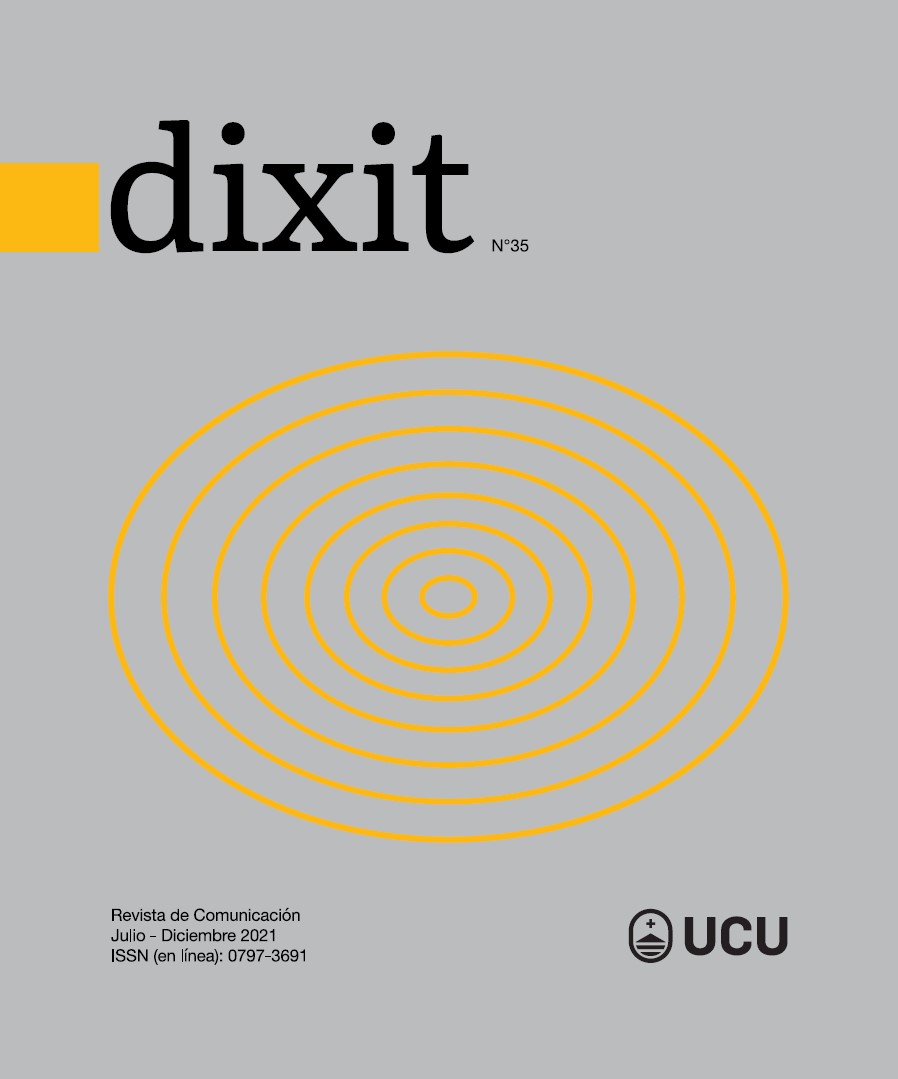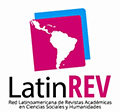From a Biological Entity to a Social Monster. A Semiotic Construction of the Coronavirus During the Covid-19 Pandemic
DOI:
https://doi.org/10.22235/d35.2650Keywords:
coronavirus, COVID-19, semiotics, representation, constructivismAbstract
During the first half of 2020, the novel coronavirus —a biological entity invisible to the human eye— was represented in multiple images, audiovisual products, descriptions, narratives and other modes of visual and verbal articulation. Many of these were developed by international organizations, governments and media outlets, amongst other social actors, with the aim of rendering the threat posed by the virus more tangible. At the same time, these representations also helped shape how people made sense of it in cognitive and emotional terms. Assuming that social reality is constructed in multiple and dynamic processes and interactions that imply the production, distribution and consumption of meaning at various levels, this article examines from a semiotic perspective one of the modes of representations of the coronavirus during the COVID-19 pandemic: the one grounded on the overarching narrative that depicted the virus as an evil enemy that poses a threat to humanity and that, consequently, needs to be fought. The article organizes the study of a number of representations of the coronavirus in three levels —the iconic, the axiological and the narrative— and discusses how the discursive construction of an enemy involves a series of mechanisms of semiotic nature that, besides somehow representing it, also shape its social construction.
*This article was originally published in 2020, in English, under the title "From a Biological Entity to a Social Monster. A Semiotic Construction of the Coronavirus During the Covid-19 Pandemic," in the Italian journal Fuori Luogo, 7(1), pp. 105-115. DOI https://doi.org/10.6092/2723-9608/7041. The translation from English to Spanish —which is unchanged from the original version, except for the addition of new bibliographic entries— was done by the author.
Downloads
References
‘If I get corona, I get corona’: the Americans who wish they’d taken Covid-19 seriously. (28 de marzo de 2020). The Guardian. Recuperado de https://www.theguard-ian.com/lifeandstyle/2020/mar/28/americans-who-dont-take-coronavirus-seri¬ously
Andacht, F. (6 de junio de 2020). El nada discreto desencanto de la unanimidad. eXtramuros, 2. Recuperado de https://extramurosrevista.org/el-nada-discreto-desencanto-de-la-unanimidad/
Arfuch, L. (Ed.) (2005). Identidades, sujetos, subjetividades. Buenos Aires, Argentina: Prometeo.
Battistelli, F. (2020). Coronavirus: metafore di guerra e confusione di concetti. MicroMega. Recuperado de http://temi.repubblica.it/micromega-online/coronavirus-metafore-di-guerra-e-confusione-di-concetti/
Berger, P., y Luckmann, T. (1966). La construcción social de la realidad. Buenos Aires, Argentina: Amorrortu.
Bitonte, M. E. (2008). La socio-semiótica como forma de pensamiento crítico. De la teoría al trabajo sobre configuraciones materiales. Perspectivas de la comunicación, 1(2), 59-71.
Cassandro, D. (22 de marzo de 2020). Siamo in guerra! Il coronavirus e le sue metafore. Internazionale. Recuperado de https://www.internazionale.it/opinione/daniele-cassandro/2020/03/22/coronavirus-metafore-guerra
Demaria, C. (2019). Teoria di genere. Femminismi e semiotica. Milán, Italia: Bompiani.
Demuru, P. (2017). Praticas de vida. Entre semiótica, comunicação e política. Estudos semióticos, 13(1), 28-39.
Descola, P. (2005). Par-delà nature et culture. París, Francia: Gallimard.
Eco, U. (1999). Kant y el ornitorrinco. Barcelona, España: Lumen.
Eco, U. (2000). Tratado de semiótica general. Barcelona, España: Lumen.
Eco, U. (2011). Construir al enemigo y otros escritos. Barcelona, España: Lumen.
European Comission. (2020). WEBINAR: Covid-19 health response package. Recuperado de https://ec.europa.eu/cyprus/events/20201029_1_en
Evil Coronavirus (COVID-19). Cartoon Character of Pathogenic Bacteria In A Prohibited Symbol [Fotografía]. (2020). 123RF. Recuperado de https://es.123rf.com/photo_142342030_evil-coronavirus-COVID-19-cartoon-character-of-pathogenic-bacteria-in-a-prohibited-symbol-vector-ill.html
Fabbri, P. (1998). El giro semiótico. Barcelona, España: Gedisa.
Fontanille, J. (2008). Pratiques sémiotiques. París, Francia: Presses Universitaires de France.
Fontanille, J. (2015a). Formes de vie: des jeux de langage à la phénoménologie des cultures. Metodo. International Studies in Phenomenology and Philosophy, 3(1), 21-40.
Fontanille, J. (2015b). Formes de vie. Lieja, Bélgica: Presses Universitaires de Liège.
Forster, V. (20 de abril de 2020). There Is A Coronavirus Coloring Book Designed To Help Children Cope With The Pandemic. Forbes. Recuperado de https://www.forbes.com/sites/victoriaforster/2020/04/02/there-is-a-coronavirus-coloring-book-designed-to-help-children-cope-with-the-pandemic/#2d1676333ca5
Free-Lanced in Lockdown. (5 de Agosto de 2020). Safrea Chronicle. Recuperado de https://safreachronicle.co.za/free-%E2%80%95-lanced-in-lockdown/
Geertz, C. (1973). The Interpretation of Cultures. Nueva York, NY: Basic Books.
Giaimo, C. (1 de abril de 2020). The Spiky Blob Seen Around the World. The New York Times. Recuperado de https://www.nytimes.com/2020/04/01/health/coronavirus-illustration-cdc.html
Greimas, A. J. (1984). Sémiotique figurative et sémiotique plastique. Actes sémiotiques, 6(60), 05-24.
Greimas, A. J., y Courtès, J. (1979). Sémiotique. Dictionnaire raisonné de la théorie du langage. París, Francia: Hachette.
Hauser, D. J., y Schwarz, N. (2019). The War on Prevention II: Battle Metaphors Undermine Cancer Treatment and Prevention and Do Not Increase Vigilance. Health Communication. DOI: 10.1080/10410236.2019.1663465
Hénault, A. (2012). Les enjeux de la sémiotique. París, Francia: Presses Universitaires de France.
Heroes of the Front Lines. Stories of the Courageous Workers Risking their Own Lives to Save Ours. (2020). Time. Recuperado de https://time.com/collection/coronavirus-heroes/
Hjelmslev, L. (1943). Prolegomena to a Theory of Language. Madison, WI: Wisconsin University Press.
Homer, B. D., y Plass, J. L. (2009). Expertise reversal for iconic representations in science visualizations. Instructional Science, 38, 256-276.
House of European History. (2020). History in the Making: Documenting Covid. Sarah Fighting Corona Virus [Ilustración]. Recuperado de https://historia-europa.ep.eu/en/history-making-documenting-covid?fbclid=IwAR-1mUNyzwB6k0RuKEQn7Q3fRd6-m8k-gXNhNT2aLbm0uvlw5A4b-4U-9yNI
Jasso, M. (3 de abril de 2020). #EnFotos: El coronavirus ‘se propaga’ en forma de piñata [Fotografía]. Expansión. Recuperado de https://politica.expansion.mx/cdmx/2020/04/03/enfotos-el-coronavirus-se-propaga-en-forma-de-pinata#pid=slide-0
Koschorke, A. (2009). Zur Epistemologie der Natur/Kultur-Grenze und zu ihren disziplinären Folgen. Deutsche Vierteljahrsschrift für Literaturwissenschaft und Geistesgeschicte, 83(1), 9-25.
Lakoff, G., y Johnson, M. (1986). Metáforas de la vida cotidiana. Madrid, España: Cátedra.
Landowski, E. (1997). Présences de l’autre. París, Francia: Presses Universitaires de France.
Landowski, E. (2014). Sociossemiótica: uma teoria geral do sentido. Galáxia, 27, 10-20.
Landowski, E. (2016a). A prueba del otro. Contratexto, 26, 13-29.
Landowski, E. (2016b). Interacciones arriesgadas. Lima, Perú: Fondo Editorial de la Universidad de Lima.
Landowski, E. (2019). Politiques de la sémiotique. Rivista Italiana di Filosofia del Linguaggio, 13(2), 6-25.
Made in Casa Piñatas Perú. (2020). Piñata Virus [Fotografía]. Pinterest. Recuperado de ‹https://www.pinterest.com/pin/646125877778828622/›.
Ministerio de Salud Pública. (2020). Plan Nacional Coronavirus. Recuperado de https://www.gub.uy/salud
Moreno Barreneche, S. (2020a). Somebody to Blame. On the Construction of the Other in the Context of the COVID-19. Society Register, 4(2), 19-32.
Moreno Barreneche, S. (2020b). Mind the Gap! On the Discursive Construction of Collective Political Identities. Punctum, 6(2), 11-27.
Moreno Barreneche, S. (2020c). Migración y ‘cultura del miedo’: estudio sociosemiótico. Estudios, 43, 65-82.
Moreno Barreneche, S. (2021). Los héroes de la pandemia: la construcción discursiva del colectivo de ‘los trabajadores sanitarios’ durante la crisis del COVID-19. CS, 33, 75-101.
Mouffe, C. (2007). En torno a lo político. Ciudad de México, México: Fondo de Cultura Económica.
Naciones Unidas. (2020). Information from the UN System. Recuperado de https://www.un.org/en/coronavirus/information-un-system
Onuf, N. (1989). A World of Our Making. Columbia, SC: University of South Carolina Press.
Pacheco Miranda, T., y Pinto da Costa, I. (19 de junio de 2020). Eis o mural de Vhils no Hospital de São João. Porque “os profissionais de saúde também precisam de ser cuidados”. Público. Recuperado de https://www.publico.pt/2020/06/19/p3/noticia/eis-mural-vhils-hospital-sao-joao-profissionais-saude-tambem-precisam-cuidados-1921173
Paolucci, C. (2012). Sens et cognition. La narrativité entre sémiotique et sciences cognitive. Signata, 3, 299-316.
Paolucci, C. (2020). Cognitive Semiotics. Integrating Signs, Minds, Meaning and Cognition. Berlín, Alemania/Nueva York, NY: Springer.
Peruzzo, N., y Rodríguez Juele, A. (2020). Coco & Fran contra el coronavirus. Guía informativa de Covid-19. Montevideo, Uruguay: Bandas Educativas/Instituto Clemente Estable. Recuperado de https://www.comicbacterias.com/wp-content/uploads/2020/05/Coco-y-Fran-contra-el-Coronavirus.pdf
Propp, V. (2000). Morfología del cuento. Madrid, España: Fundamentos.
Searle, J. (1995). The Construction of Social Reality. Londres, Reino Unido: Penguin.
Sontag, S. (1978). Illness as Metaphor. Nueva York, NY: Farrar, Straus and Giroux.
Talbot, N. (10 de abril de 2020). Corona Diaries: Branding the Spiky Blob. Medium.com. Recuperado de https://medium.com/@niccitalbot/corona-diaries-branding-the-spiky-blob-b2942df2906b
Testa, A. (30 de marzo de 2020). Smettiamo di dire che è una guerra. Internazionale. Recuperado de https://www.internazionale.it/opinione/annamaria-testa/2020/03/30/metafora-guerra-coronavirus
The aliens among us. How viruses shape the world. (22 de Agosto de 2020). The Economist. Recuperado de https://www.economist.com/leaders/2020/08/22/how-viruses-shape-the-world
The European Research Council Magazine. (10 de marzo de 2020). Coronavirus: What’s beyond the science frontier. Recuperado de https://erc.europa.eu/news-events/magazine/coronavirus-what-s-beyond-science-frontier
Traini, S. (2006). Le due vie della semiotica. Teorie strutturali e interpretative. Milán, Italia: Bompiani.
Van Leeuwen, T. (2005). Introducing Social Semiotics. Londres, Reino Unido: Routledge.
Verón, E. (1981). Construir el acontecimiento. Barcelona, España: Gedisa.
Verón, E. (1988). La semiosis social. Barcelona, España: Gedisa.
Violi, P. (2017). Due vie per la semiotica o un incrocio di sguardi? Algirdas Greimas e Umberto Eco a confronto. Entornos, 30(1), 25-33.
Downloads
Published
How to Cite
Issue
Section
License
Copyright (c) 2021 Dixit

This work is licensed under a Creative Commons Attribution 4.0 International License.
From issue number 32 onwards all contents are licensed under the Creative Commons Attribution 4.0 International License (CC BY 4.0).
Issues number 29-31 are licensed under the Creative Commons Attribution-NonCommercial 4.0 International License.
The contents corresponding to number 28 and earlier editions are under the Creative Commons Attribution-NonCommercial-ShareAlike 4.0 International License.


















